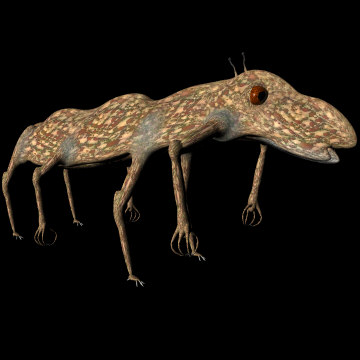
 |
|||||||
|
|
|
|
|
|
|
Lagrush |
 |
|||
Homeworld: |
Lagrush, Sector 8 | |||
Ecology: |
Nitrogen-Oxygen-Water | |||
Biology: |
DNA II | |||
Languages: |
Native languages | |||
Human Contact: |
2222CE | |||
FTL Status: |
n/a - protected race | |||
Current Status: |
Protected under the Schalmar Durgha Accords | |||
Environment |
Ideal |
Tolerance |
||
Atmosphere: |
.28B O2; .06 CO2 | .21-.35B O2; .04 -.08 CO2 | ||
Temperature: |
295K | 280-320K | ||
Gravity: |
0.53G | 0.2-0.8G | ||
Other: |
Humidity 30% | Humidity 02-95% | ||
The Lagrush were the fourth intelligent race encountered by Humanity. Living on a desolate gas giant moon, this species possesses a highly rigid caste-based society, locked for tens of thousands of years into a mechanistic hive-like early industrial culture.
The Lagrush are eight-limbed bilaterally symmetrical quadrupeds, whose rear (first) and third set of limbs are used as legs and whose fore (fourth) and second set of limbs are arms that end in articulated four-fingered hands. Adult size varies with caste, from small (one meter long and thirty kilos) to large (five meters long and nearly two tons mass). The Lagrush body has a basically triangular cross section, with a larger upper spine and two thinner vertice spines forming the articulated frame of the body. The head ends in a triangular snout that encloses multiple rows of specialized teeth, allowing a varying omnivorous diet. The snout contains sacks that support reparation, communication and olfactory sensors. Two large eyes protrude form the sides of the head and two antenna-like structures rise from the sides of the upper spine to provide auditory and pressure sensory input. Internally, the Lagrush maintains an extremely bilateral structure, with two or four sets of all major organs, including two parallel digestive tracts that end in two separate anuses.
Lagrush coloration is generally a spotted brown or tan, though some castes can be black, white or yellow in primary hue. Lagrush wear no clothing or external ornamentation.
Lagrush have no gender. Al individuals are hermaphrodites that can secrete male or female gametes for external fertilization. Lagrush society is based autonomous towns that function as hierarchical hives. Lagrush individuals belong to one of at least eight hundred separate castes, each performing a specific occupation within the town. Castes types include food production, industrial workers, servicers, and soldiers, with each specific caste performing a highly limited, repetitive and stylized function within a general category. Specific leadership castes exist for each caste type, but no overall leader caste exists. Interbreeding between castes is non-existent, though transfers of individuals between towns allow for some genetic diversity, and the various castes are well on their way towards speciation. Most castes have limited mental facilities and would not qualify as sentient by established standards. Even leadership castes members have limited intelligence, rigid behavioral patterns and little creativity. Despite their early Industrial Age civilization, complete with steam engines, factories and steel furnaces, the Lagrush could be classified as non-sentient.
Lagrush society has no literature, art or religion. The town is the focus of identity and individuals are little more than cogs in the town's machinery. Lagrush develop from fertilized eggs and spend a short childhood in caste crèches. They toil at their specialty for approximately thirty standard years before succumbing to old age, laying down to die and to be recycled by the food processing castes. Lagrush language has auditory and olfactory components, a limited common vocabulary and a rigid grammar. Castes have specific subvocabularies related to their specialization.
The Lagrush evolved from omnivorous herd animals on the semi-arid steppes and badlands of their dry world. The proto-Lagrush possessed fewer castes and higher intelligence than their descendants, and formed villages and agricultural communities in the more hospitable valleys and river regions of the world's supercontinent. A pre-industrialized civilization, one with evidence of art and some cultural activities, began around 70,000BC and cumulated in the beginnings of an industrial society around 63,000BC.
Over the next several millennia, Lagrush society became more rigid. Evidence of artwork ceased, and Lagrush towns became enclosed, isolated and occasionally warring compounds. The establishment of the persistent rigid caste structure was evident by 58,000BC. Since that era, Lagrush society has effectively reached a stasis, locked in an early industrial mechanistic culture.
The Lagrush remain unchanged, unable to comprehend any alteration in their culture. Twelve thousand towns of ten to twenty thousand individuals are scattered across their world. Some of these towns are tens of thousands of years old, spherical iron structures rising on hills of slag and debris hundreds of meters tall. Stylized warfare and trade over resources and water rights mark relations between the towns. The Lagrush remain under a quarantine supervised by the League of Independent Races and the Alimeen Confederation. Their society is expected to remain static for millennia or perhaps millions of years to come, baring some ecological disaster.
Xenologists continue to debate the sentience of the Lagrush. While their ancestors clearly had sufficient intellectual capacity to develop an industrial society, the current castes of the Lagrush have devolved into near instinctual beings.
All pages and images ©1999 - 2006
by Geir Lanesskog, All Rights Reserved
Usage Policy
![]()